An Analysis of Child Labor and Business Ethics in Australia
VerifiedAdded on 2021/06/16
|6
|1590
|88
Report
AI Summary
This report delves into the pervasive ethical issue of child labor, focusing specifically on its presence within Australia and the practices of Australian businesses. It highlights the exploitation of children in the production of everyday goods, such as food and cosmetics, both domestically and internationally within the supply chains of Australian companies. The report critiques the lack of a standardized minimum working age across Australian states and the country's failure to ratify the Minimum Age Convention of 1973, identifying inconsistencies in child labor laws and their enforcement. It examines specific scandals involving major supermarkets sourcing from companies using child labor and the exploitation of children in orphanages. The report explores four different approaches to business ethics, including the Friedman Doctrine, cultural relativism, the righteous moralist, and the naïve immoralist, assessing their impact on the issue. It concludes by emphasizing the responsibilities of the government, businesses, and consumers in addressing child labor, advocating for stronger laws, greater public awareness, and ethical supply chain management. The report stresses the urgent need for standardized federal laws and highlights the importance of setting a minimum age for employment to protect children from exploitation.
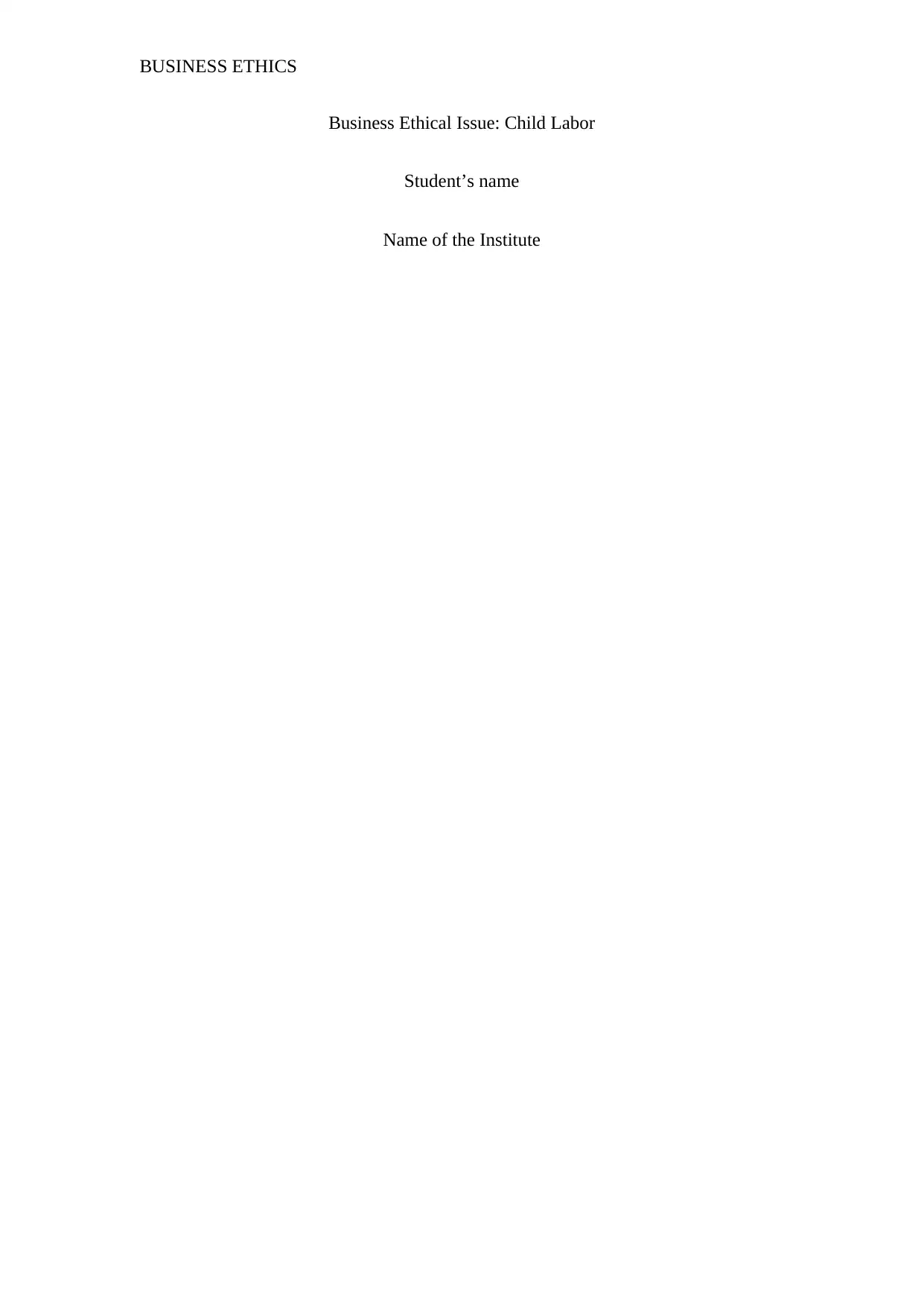
BUSINESS ETHICS
Business Ethical Issue: Child Labor
Student’s name
Name of the Institute
Business Ethical Issue: Child Labor
Student’s name
Name of the Institute
Paraphrase This Document
Need a fresh take? Get an instant paraphrase of this document with our AI Paraphraser
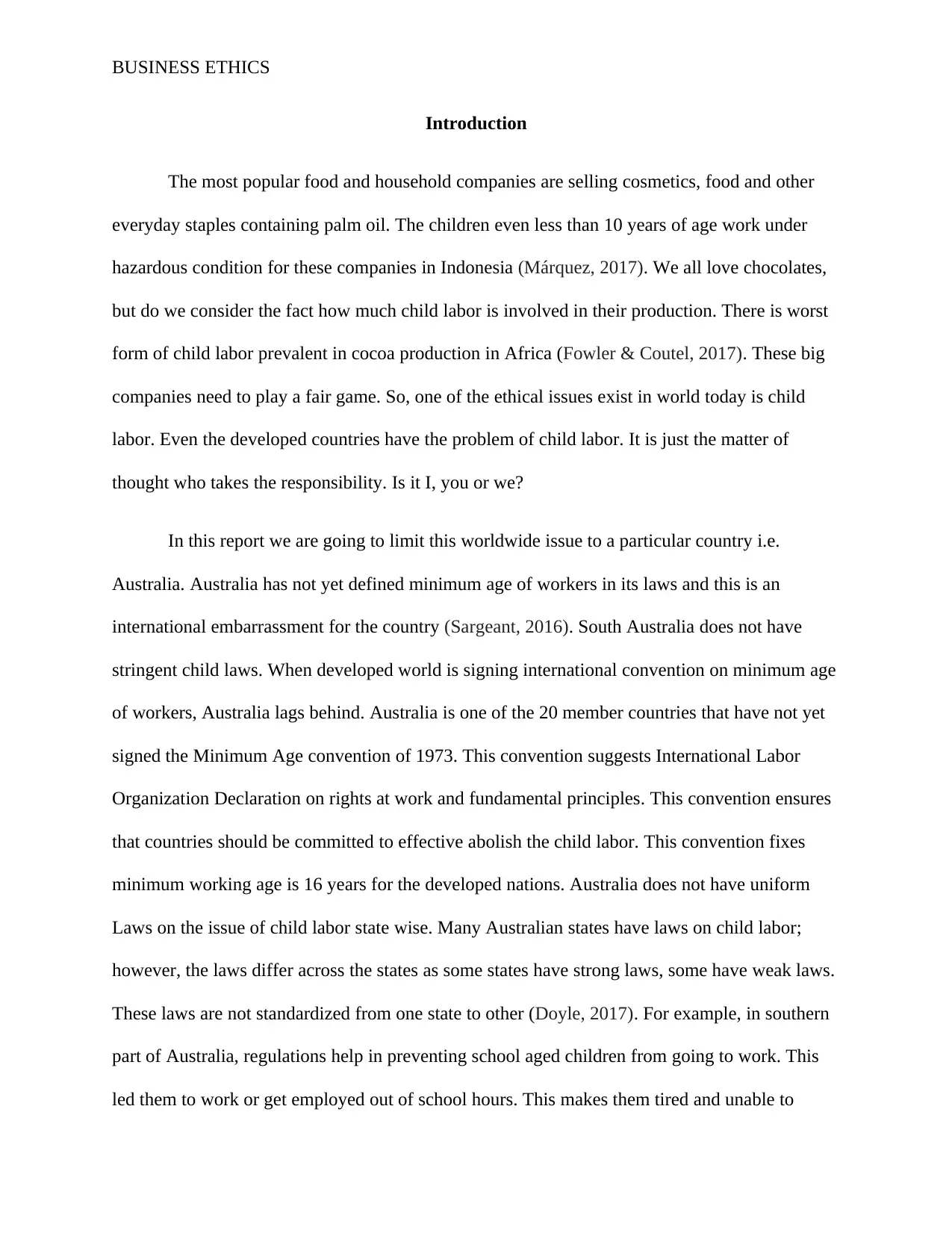
BUSINESS ETHICS
Introduction
The most popular food and household companies are selling cosmetics, food and other
everyday staples containing palm oil. The children even less than 10 years of age work under
hazardous condition for these companies in Indonesia (Márquez, 2017). We all love chocolates,
but do we consider the fact how much child labor is involved in their production. There is worst
form of child labor prevalent in cocoa production in Africa (Fowler & Coutel, 2017). These big
companies need to play a fair game. So, one of the ethical issues exist in world today is child
labor. Even the developed countries have the problem of child labor. It is just the matter of
thought who takes the responsibility. Is it I, you or we?
In this report we are going to limit this worldwide issue to a particular country i.e.
Australia. Australia has not yet defined minimum age of workers in its laws and this is an
international embarrassment for the country (Sargeant, 2016). South Australia does not have
stringent child laws. When developed world is signing international convention on minimum age
of workers, Australia lags behind. Australia is one of the 20 member countries that have not yet
signed the Minimum Age convention of 1973. This convention suggests International Labor
Organization Declaration on rights at work and fundamental principles. This convention ensures
that countries should be committed to effective abolish the child labor. This convention fixes
minimum working age is 16 years for the developed nations. Australia does not have uniform
Laws on the issue of child labor state wise. Many Australian states have laws on child labor;
however, the laws differ across the states as some states have strong laws, some have weak laws.
These laws are not standardized from one state to other (Doyle, 2017). For example, in southern
part of Australia, regulations help in preventing school aged children from going to work. This
led them to work or get employed out of school hours. This makes them tired and unable to
Introduction
The most popular food and household companies are selling cosmetics, food and other
everyday staples containing palm oil. The children even less than 10 years of age work under
hazardous condition for these companies in Indonesia (Márquez, 2017). We all love chocolates,
but do we consider the fact how much child labor is involved in their production. There is worst
form of child labor prevalent in cocoa production in Africa (Fowler & Coutel, 2017). These big
companies need to play a fair game. So, one of the ethical issues exist in world today is child
labor. Even the developed countries have the problem of child labor. It is just the matter of
thought who takes the responsibility. Is it I, you or we?
In this report we are going to limit this worldwide issue to a particular country i.e.
Australia. Australia has not yet defined minimum age of workers in its laws and this is an
international embarrassment for the country (Sargeant, 2016). South Australia does not have
stringent child laws. When developed world is signing international convention on minimum age
of workers, Australia lags behind. Australia is one of the 20 member countries that have not yet
signed the Minimum Age convention of 1973. This convention suggests International Labor
Organization Declaration on rights at work and fundamental principles. This convention ensures
that countries should be committed to effective abolish the child labor. This convention fixes
minimum working age is 16 years for the developed nations. Australia does not have uniform
Laws on the issue of child labor state wise. Many Australian states have laws on child labor;
however, the laws differ across the states as some states have strong laws, some have weak laws.
These laws are not standardized from one state to other (Doyle, 2017). For example, in southern
part of Australia, regulations help in preventing school aged children from going to work. This
led them to work or get employed out of school hours. This makes them tired and unable to
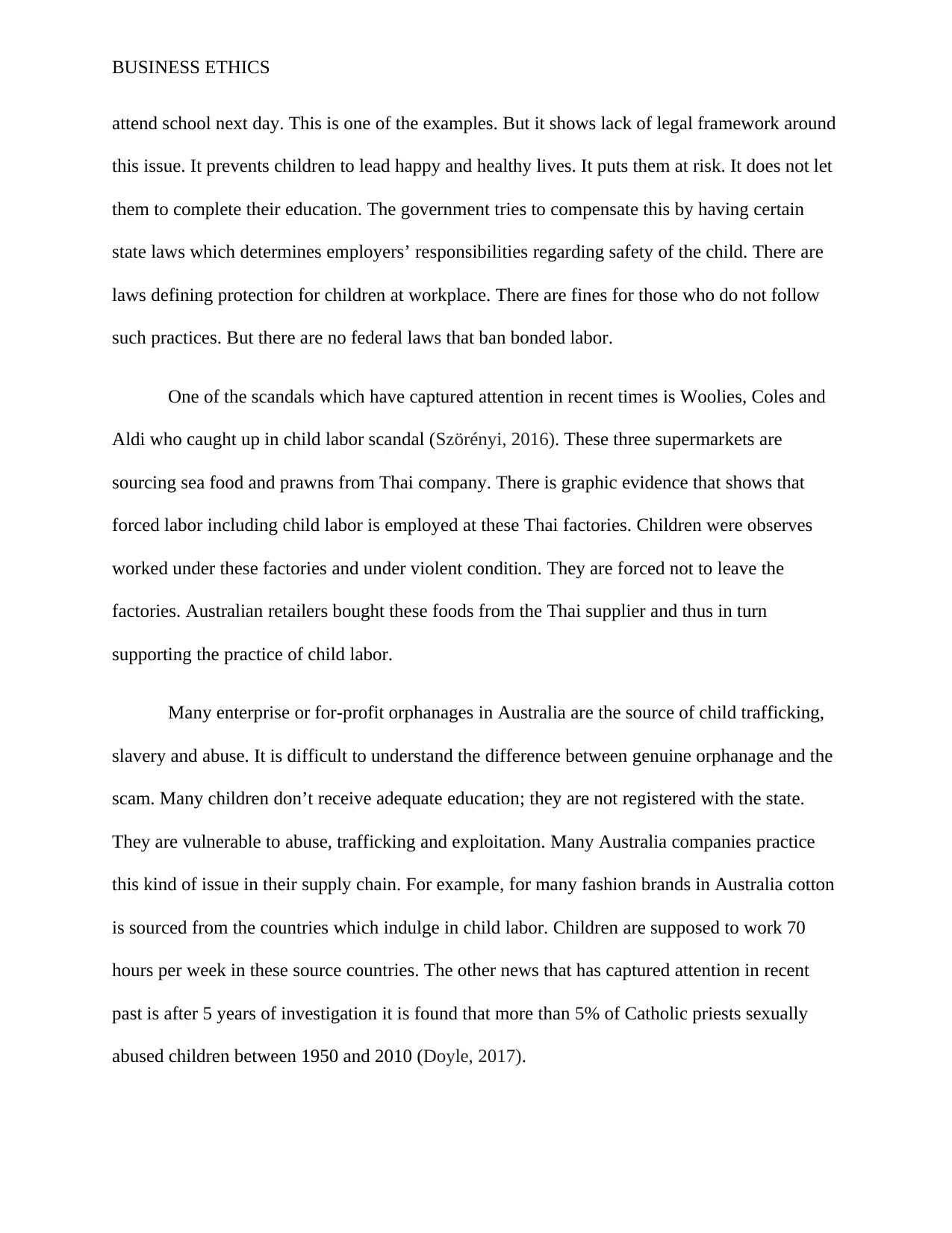
BUSINESS ETHICS
attend school next day. This is one of the examples. But it shows lack of legal framework around
this issue. It prevents children to lead happy and healthy lives. It puts them at risk. It does not let
them to complete their education. The government tries to compensate this by having certain
state laws which determines employers’ responsibilities regarding safety of the child. There are
laws defining protection for children at workplace. There are fines for those who do not follow
such practices. But there are no federal laws that ban bonded labor.
One of the scandals which have captured attention in recent times is Woolies, Coles and
Aldi who caught up in child labor scandal (Szörényi, 2016). These three supermarkets are
sourcing sea food and prawns from Thai company. There is graphic evidence that shows that
forced labor including child labor is employed at these Thai factories. Children were observes
worked under these factories and under violent condition. They are forced not to leave the
factories. Australian retailers bought these foods from the Thai supplier and thus in turn
supporting the practice of child labor.
Many enterprise or for-profit orphanages in Australia are the source of child trafficking,
slavery and abuse. It is difficult to understand the difference between genuine orphanage and the
scam. Many children don’t receive adequate education; they are not registered with the state.
They are vulnerable to abuse, trafficking and exploitation. Many Australia companies practice
this kind of issue in their supply chain. For example, for many fashion brands in Australia cotton
is sourced from the countries which indulge in child labor. Children are supposed to work 70
hours per week in these source countries. The other news that has captured attention in recent
past is after 5 years of investigation it is found that more than 5% of Catholic priests sexually
abused children between 1950 and 2010 (Doyle, 2017).
attend school next day. This is one of the examples. But it shows lack of legal framework around
this issue. It prevents children to lead happy and healthy lives. It puts them at risk. It does not let
them to complete their education. The government tries to compensate this by having certain
state laws which determines employers’ responsibilities regarding safety of the child. There are
laws defining protection for children at workplace. There are fines for those who do not follow
such practices. But there are no federal laws that ban bonded labor.
One of the scandals which have captured attention in recent times is Woolies, Coles and
Aldi who caught up in child labor scandal (Szörényi, 2016). These three supermarkets are
sourcing sea food and prawns from Thai company. There is graphic evidence that shows that
forced labor including child labor is employed at these Thai factories. Children were observes
worked under these factories and under violent condition. They are forced not to leave the
factories. Australian retailers bought these foods from the Thai supplier and thus in turn
supporting the practice of child labor.
Many enterprise or for-profit orphanages in Australia are the source of child trafficking,
slavery and abuse. It is difficult to understand the difference between genuine orphanage and the
scam. Many children don’t receive adequate education; they are not registered with the state.
They are vulnerable to abuse, trafficking and exploitation. Many Australia companies practice
this kind of issue in their supply chain. For example, for many fashion brands in Australia cotton
is sourced from the countries which indulge in child labor. Children are supposed to work 70
hours per week in these source countries. The other news that has captured attention in recent
past is after 5 years of investigation it is found that more than 5% of Catholic priests sexually
abused children between 1950 and 2010 (Doyle, 2017).
⊘ This is a preview!⊘
Do you want full access?
Subscribe today to unlock all pages.

Trusted by 1+ million students worldwide
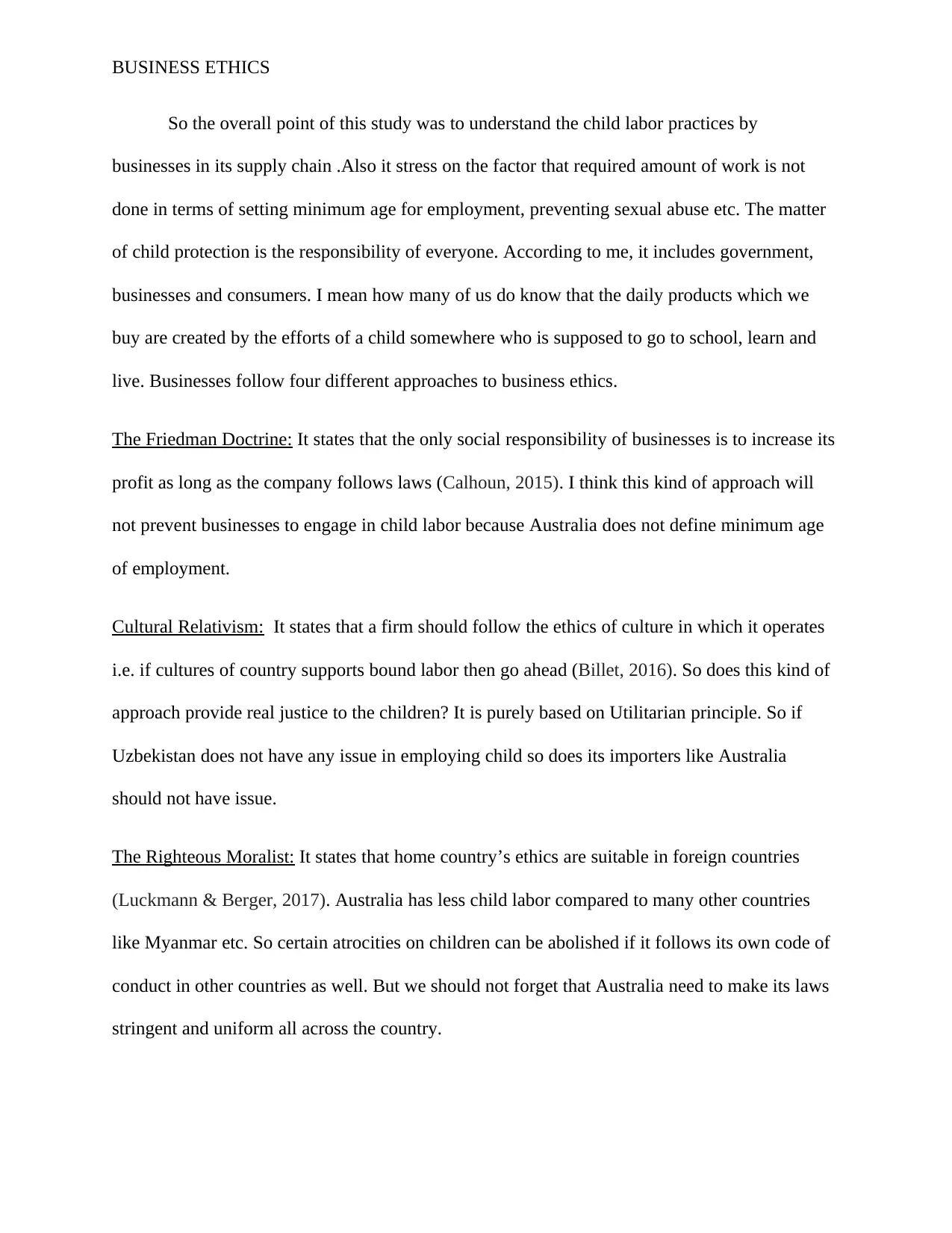
BUSINESS ETHICS
So the overall point of this study was to understand the child labor practices by
businesses in its supply chain .Also it stress on the factor that required amount of work is not
done in terms of setting minimum age for employment, preventing sexual abuse etc. The matter
of child protection is the responsibility of everyone. According to me, it includes government,
businesses and consumers. I mean how many of us do know that the daily products which we
buy are created by the efforts of a child somewhere who is supposed to go to school, learn and
live. Businesses follow four different approaches to business ethics.
The Friedman Doctrine: It states that the only social responsibility of businesses is to increase its
profit as long as the company follows laws (Calhoun, 2015). I think this kind of approach will
not prevent businesses to engage in child labor because Australia does not define minimum age
of employment.
Cultural Relativism: It states that a firm should follow the ethics of culture in which it operates
i.e. if cultures of country supports bound labor then go ahead (Billet, 2016). So does this kind of
approach provide real justice to the children? It is purely based on Utilitarian principle. So if
Uzbekistan does not have any issue in employing child so does its importers like Australia
should not have issue.
The Righteous Moralist: It states that home country’s ethics are suitable in foreign countries
(Luckmann & Berger, 2017). Australia has less child labor compared to many other countries
like Myanmar etc. So certain atrocities on children can be abolished if it follows its own code of
conduct in other countries as well. But we should not forget that Australia need to make its laws
stringent and uniform all across the country.
So the overall point of this study was to understand the child labor practices by
businesses in its supply chain .Also it stress on the factor that required amount of work is not
done in terms of setting minimum age for employment, preventing sexual abuse etc. The matter
of child protection is the responsibility of everyone. According to me, it includes government,
businesses and consumers. I mean how many of us do know that the daily products which we
buy are created by the efforts of a child somewhere who is supposed to go to school, learn and
live. Businesses follow four different approaches to business ethics.
The Friedman Doctrine: It states that the only social responsibility of businesses is to increase its
profit as long as the company follows laws (Calhoun, 2015). I think this kind of approach will
not prevent businesses to engage in child labor because Australia does not define minimum age
of employment.
Cultural Relativism: It states that a firm should follow the ethics of culture in which it operates
i.e. if cultures of country supports bound labor then go ahead (Billet, 2016). So does this kind of
approach provide real justice to the children? It is purely based on Utilitarian principle. So if
Uzbekistan does not have any issue in employing child so does its importers like Australia
should not have issue.
The Righteous Moralist: It states that home country’s ethics are suitable in foreign countries
(Luckmann & Berger, 2017). Australia has less child labor compared to many other countries
like Myanmar etc. So certain atrocities on children can be abolished if it follows its own code of
conduct in other countries as well. But we should not forget that Australia need to make its laws
stringent and uniform all across the country.
Paraphrase This Document
Need a fresh take? Get an instant paraphrase of this document with our AI Paraphraser
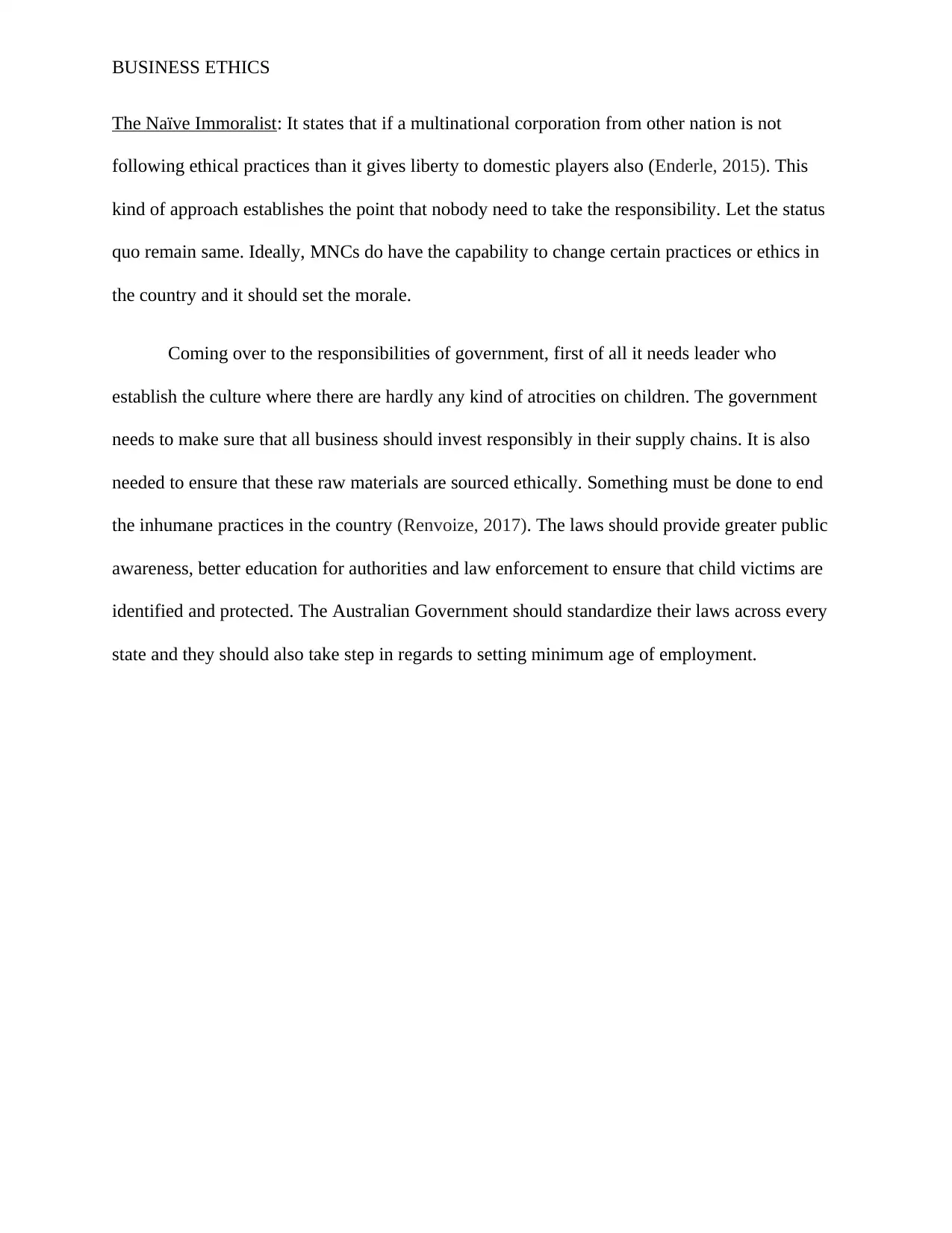
BUSINESS ETHICS
The Naïve Immoralist: It states that if a multinational corporation from other nation is not
following ethical practices than it gives liberty to domestic players also (Enderle, 2015). This
kind of approach establishes the point that nobody need to take the responsibility. Let the status
quo remain same. Ideally, MNCs do have the capability to change certain practices or ethics in
the country and it should set the morale.
Coming over to the responsibilities of government, first of all it needs leader who
establish the culture where there are hardly any kind of atrocities on children. The government
needs to make sure that all business should invest responsibly in their supply chains. It is also
needed to ensure that these raw materials are sourced ethically. Something must be done to end
the inhumane practices in the country (Renvoize, 2017). The laws should provide greater public
awareness, better education for authorities and law enforcement to ensure that child victims are
identified and protected. The Australian Government should standardize their laws across every
state and they should also take step in regards to setting minimum age of employment.
The Naïve Immoralist: It states that if a multinational corporation from other nation is not
following ethical practices than it gives liberty to domestic players also (Enderle, 2015). This
kind of approach establishes the point that nobody need to take the responsibility. Let the status
quo remain same. Ideally, MNCs do have the capability to change certain practices or ethics in
the country and it should set the morale.
Coming over to the responsibilities of government, first of all it needs leader who
establish the culture where there are hardly any kind of atrocities on children. The government
needs to make sure that all business should invest responsibly in their supply chains. It is also
needed to ensure that these raw materials are sourced ethically. Something must be done to end
the inhumane practices in the country (Renvoize, 2017). The laws should provide greater public
awareness, better education for authorities and law enforcement to ensure that child victims are
identified and protected. The Australian Government should standardize their laws across every
state and they should also take step in regards to setting minimum age of employment.
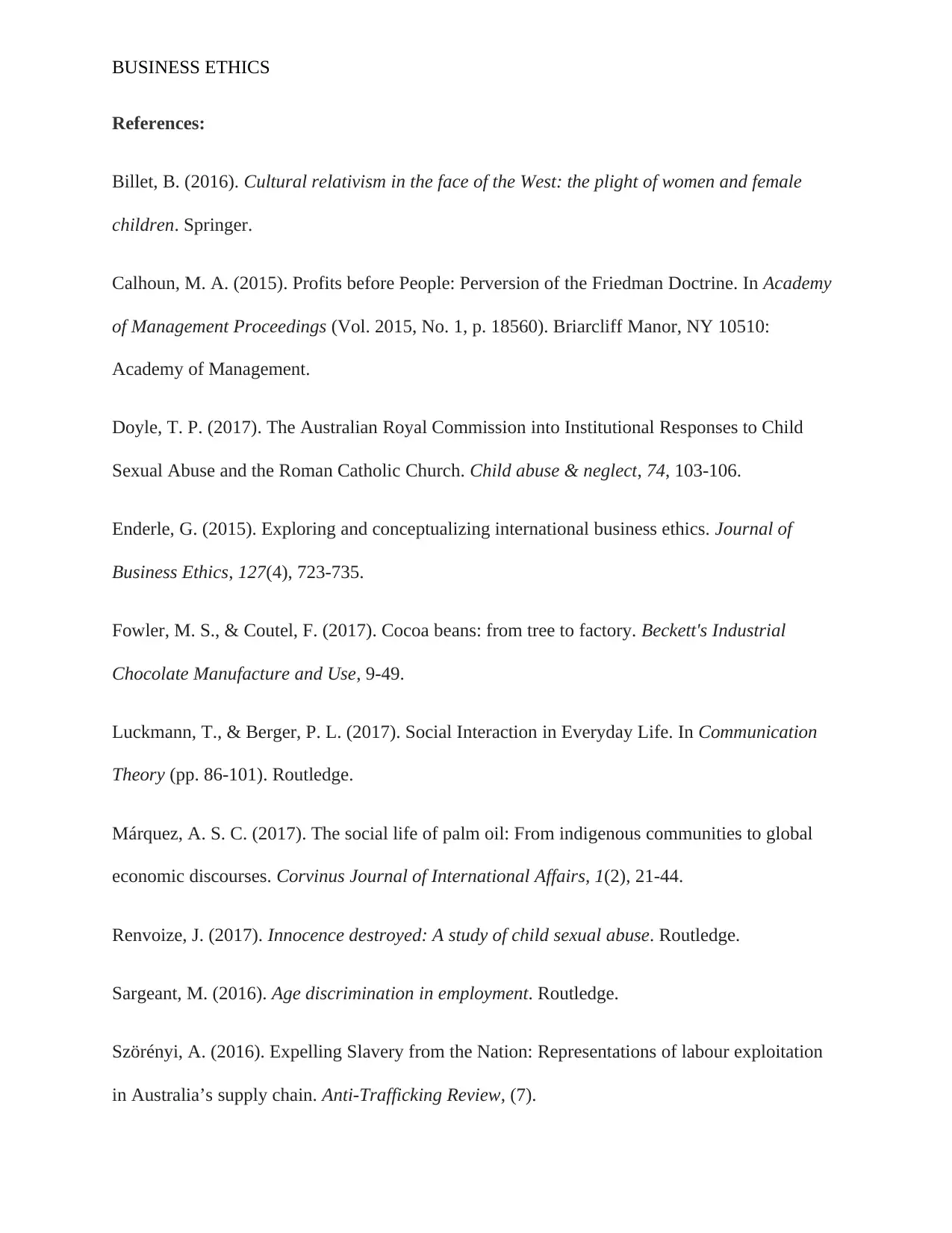
BUSINESS ETHICS
References:
Billet, B. (2016). Cultural relativism in the face of the West: the plight of women and female
children. Springer.
Calhoun, M. A. (2015). Profits before People: Perversion of the Friedman Doctrine. In Academy
of Management Proceedings (Vol. 2015, No. 1, p. 18560). Briarcliff Manor, NY 10510:
Academy of Management.
Doyle, T. P. (2017). The Australian Royal Commission into Institutional Responses to Child
Sexual Abuse and the Roman Catholic Church. Child abuse & neglect, 74, 103-106.
Enderle, G. (2015). Exploring and conceptualizing international business ethics. Journal of
Business Ethics, 127(4), 723-735.
Fowler, M. S., & Coutel, F. (2017). Cocoa beans: from tree to factory. Beckett's Industrial
Chocolate Manufacture and Use, 9-49.
Luckmann, T., & Berger, P. L. (2017). Social Interaction in Everyday Life. In Communication
Theory (pp. 86-101). Routledge.
Márquez, A. S. C. (2017). The social life of palm oil: From indigenous communities to global
economic discourses. Corvinus Journal of International Affairs, 1(2), 21-44.
Renvoize, J. (2017). Innocence destroyed: A study of child sexual abuse. Routledge.
Sargeant, M. (2016). Age discrimination in employment. Routledge.
Szörényi, A. (2016). Expelling Slavery from the Nation: Representations of labour exploitation
in Australia’s supply chain. Anti-Trafficking Review, (7).
References:
Billet, B. (2016). Cultural relativism in the face of the West: the plight of women and female
children. Springer.
Calhoun, M. A. (2015). Profits before People: Perversion of the Friedman Doctrine. In Academy
of Management Proceedings (Vol. 2015, No. 1, p. 18560). Briarcliff Manor, NY 10510:
Academy of Management.
Doyle, T. P. (2017). The Australian Royal Commission into Institutional Responses to Child
Sexual Abuse and the Roman Catholic Church. Child abuse & neglect, 74, 103-106.
Enderle, G. (2015). Exploring and conceptualizing international business ethics. Journal of
Business Ethics, 127(4), 723-735.
Fowler, M. S., & Coutel, F. (2017). Cocoa beans: from tree to factory. Beckett's Industrial
Chocolate Manufacture and Use, 9-49.
Luckmann, T., & Berger, P. L. (2017). Social Interaction in Everyday Life. In Communication
Theory (pp. 86-101). Routledge.
Márquez, A. S. C. (2017). The social life of palm oil: From indigenous communities to global
economic discourses. Corvinus Journal of International Affairs, 1(2), 21-44.
Renvoize, J. (2017). Innocence destroyed: A study of child sexual abuse. Routledge.
Sargeant, M. (2016). Age discrimination in employment. Routledge.
Szörényi, A. (2016). Expelling Slavery from the Nation: Representations of labour exploitation
in Australia’s supply chain. Anti-Trafficking Review, (7).
⊘ This is a preview!⊘
Do you want full access?
Subscribe today to unlock all pages.

Trusted by 1+ million students worldwide
1 out of 6
Related Documents
Your All-in-One AI-Powered Toolkit for Academic Success.
+13062052269
info@desklib.com
Available 24*7 on WhatsApp / Email
![[object Object]](/_next/static/media/star-bottom.7253800d.svg)
Unlock your academic potential
Copyright © 2020–2025 A2Z Services. All Rights Reserved. Developed and managed by ZUCOL.





